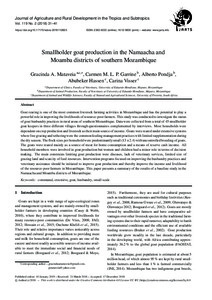Smallholder goat production in the Namaacha and Moamba districts of southern Mozambique
| dc.date.accessioned | 2019-01-17T08:18:01Z | |
| dc.date.available | 2019-01-17T08:18:01Z | |
| dc.date.issued | 2019-01-10 | |
| dc.identifier | doi:10.17170/kobra-2018112825 | |
| dc.identifier.uri | http://hdl.handle.net/123456789/11026 | |
| dc.description | Gedruckte Ausg. im Verlag Kassel Univ. Press (www.upress.uni-kassel.de) erschienen. | ger |
| dc.language.iso | eng | |
| dc.publisher | Kassel University Press | |
| dc.rights | Urheberrechtlich geschützt | |
| dc.rights.uri | https://rightsstatements.org/page/InC/1.0/ | |
| dc.subject | communal | eng |
| dc.subject | extensive | eng |
| dc.subject | goat | eng |
| dc.subject | husbandry | eng |
| dc.subject | small-scale | eng |
| dc.subject.ddc | 630 | |
| dc.title | Smallholder goat production in the Namaacha and Moamba districts of southern Mozambique | eng |
| dc.type | Aufsatz | ger |
| dcterms.abstract | Goat rearing is one of the most common livestock farming activities in Mozambique and has the potential to play a powerful role in improving the livelihoods of resource-poor farmers. This study was conducted to investigate the status of goat husbandry practices in rural areas of southern Mozambique. Data were collected from a total of 45 smallholder goat keepers in three different villages through questionnaires complemented by interviews. Most households were dependent on crop production and livestock as their main source of income. Goats were reared under extensive systems where free grazing and tethering were the common feeding management practices with limited supplementation during the dry season. The flock sizes per household were predominantly small (13 ± 2.4) with uncontrolled breeding of goats. The goats were reared mainly as a source of meat for home consumption and a means of reserve cash income. All household members were involved in goat production but women and children had a minor role in terms of decision making. The main constrains limiting goat production were diseases, lack of veterinary services, limited size of grazing land and scarcity of feed resources. Intervention programs focused on improving the husbandry practices and veterinary assistance should be initiated to improve goat production and thereby improve the income and livelihood of the resource-poor farmers in Mozambique. This paper presents a summary of the results of a baseline study in the Namaacha and Moamba districts of Mozambique. | eng |
| dcterms.accessRights | open access | |
| dcterms.creator | Mataveia, Gracinda A. | |
| dcterms.creator | Garrine, Carmen M. L. P. | |
| dcterms.creator | Pondja, Alberto | |
| dcterms.creator | Hassen, Abubeker | |
| dcterms.creator | Visser, Carina | |
| dc.type.version | publishedVersion | |
| dcterms.source.identifier | 1612-9830 | |
| dcterms.source.identifier | 2363-6033 | |
| dcterms.source.issue | No. 2 | |
| dcterms.source.journal | Journal of Agriculture and Rural Development in the Tropics and Subtropics (JARTS) | eng |
| dcterms.source.pageinfo | 31-41 | |
| dcterms.source.volume | Vol. 119 |

